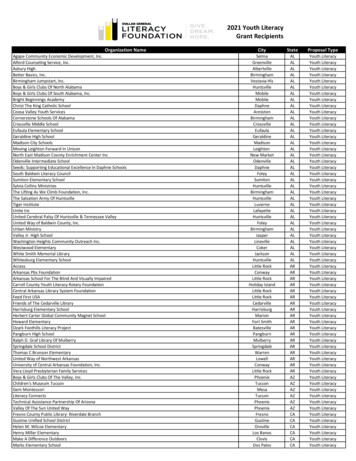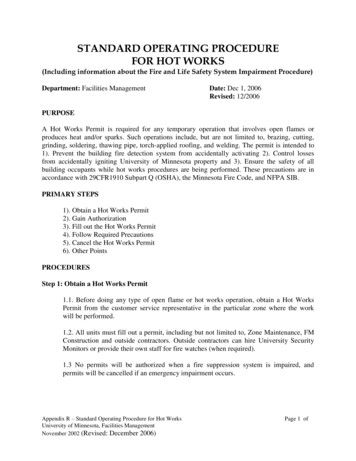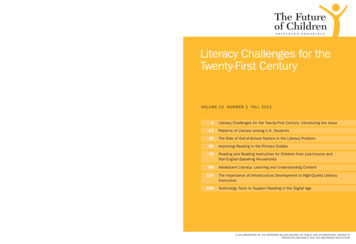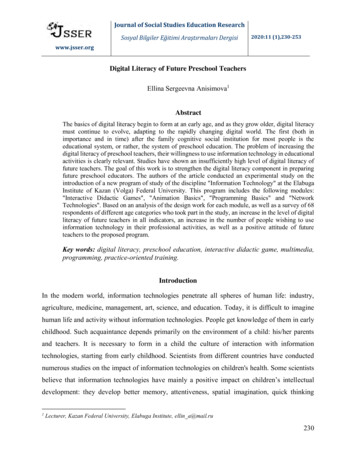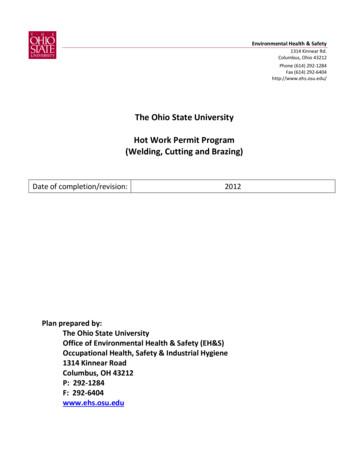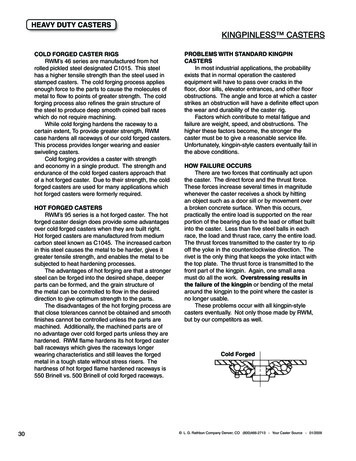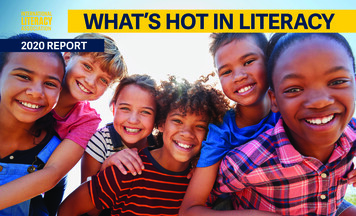
Transcription
WHAT’S HOT IN LITERACY2020 REPORTILA 2020 What’s Hot in Literacy Report INTERNATIONAL LITERACY ASSOCIATION literacyworldwide.org/whatshot
ContentsIntroduction 3Methodology 4Survey Respondents 5Executive Summary 6A Closer LookI.Improving Literacy Outcomes: Setting the Stage 8II. Addressing Instructional Inequity 19III. Ensuring Excellence in Reading Instruction 24IV. Promoting Access and Opportunity 34Topic Comparisons 40Appendix A: Acknowledgments 41Appendix B: Locations Represented 42Appendix C: Subgroup Definitions 43ILA 2020 What’s Hot in Literacy Report INTERNATIONAL LITERACY ASSOCIATION literacyworldwide.org/whatshot2
IntroductionTHE INTERNATIONAL LITERACY ASSOCIATION (ILA) has long published the findings of theWhat’s Hot in Literacy survey to note trends and foster critical conversations in literacy.What’s Hot first appeared in the members-only newspaper of the International Reading Association—nowILA—in 1997 under the title What’s Hot, What’s Not. The original survey took the temperature of a list oftopics deemed important by a sample of approximately 25 literacy leaders.By 2001, the questions What should be hot? and What shouldn’t be hot? were added, painting a morecomprehensive picture of what the hot topics in reading and writing instruction should be and how theconversations in education needed to shift. The result was an annual, comprehensive ranking of issues.We need to cometogether as a team ofliteracy professionals tocooperatively address theliteracy issues and needsfacing today’s students inour modern world.—Classroom Teacher,United StatesIn 2017, ILA redesigned the survey and launched a broader outreach, reaching a cross-sector of literacyleaders and getting input from more than 1,000 of them. The following year, ILA partnered with YouGov,a global market research firm, to collaborate on and manage the survey and report, which then became abiennial publication.This year’s survey, again created with YouGov, reflects ILA’s commitment to generating resources that aresubstantial and relevant to the field of literacy education. Survey questions were reconfigured to allow formore expansive answers, giving respondents the opportunity to offer more insight regarding their ownexperiences and challenges in providing high-quality literacy instruction.Although previous iterations of the survey identified which topics were considered important, the goal ofthis year’s expanded survey was to better identify the needs of classroom teachers, specialized literacyprofessionals, and school principals/district administrators.Understanding more about what literacy educators say they need is crucial in advancing the literacyprofession and helping to shape the future of literacy instruction.ILA 2020 What’s Hot in Literacy Report INTERNATIONAL LITERACY ASSOCIATION literacyworldwide.org/whatshot3
MethodologyILA’S GOAL WITH THE 2020 SURVEY was to deepen engagement with survey respondents andprovide more valuable insight while still maintaining the intimate conversations that have allowed literacyprofessionals to share their views.To develop this new direction, the research included two phases, both conducted in partnership withYouGov, an independent research company:PHASE 1: Four online mini-focus groups were conducted with a cross-section of 17 literacy experts toLiteracy ability orcapacity is the baserock for understandingany instruction in anydiscipline.—Special EducationTeacher, Nigeriadiscuss the state of literacy and determine the topics to be included in the 2020 survey.PHASE 2: An online survey was conducted between August 29, 2019, and September 18, 2019. Thisyear’s survey was restructured, with Q-methodology implemented to allow respondents to prioritize topicsand rate the amount of attention these topics are receiving.Additionally, the list of topics was adjusted on the basis of the findings from and comments provided inresponse to the 2018 survey, along with the findings and comments from Phase 1.The survey also took a deeper dive into several areas that were addressed in the focus groups. As a result,additional questions were included to allow participants to expand on their selections and offer insight.The survey closed with 1,443 total respondents from 65 countries and territories. The quotes used in thisreport were sourced from open-ended responses offered in the quantitative survey.ILA 2020 What’s Hot in Literacy Report INTERNATIONAL LITERACY ASSOCIATION literacyworldwide.org/whatshot4
Survey RespondentsTOP RESPONDINGCOUNTRIES United States Canada Australia New Zealand Philippines Jamaica Nigeria India South Africa United Kingdom 1,443 total respondents from 65 countries and territories EXPERIENCE Roles Among TeachersAge of StudentsEMPLOYMENT56% TEACHERS37% HIGHER EDUCATION PROFESSIONALS19% LITERACY CONSULTANTS10% PRE-K–12 ADMINISTRATORSILA 2020 What’s Hot in Literacy Report INTERNATIONAL LITERACY ASSOCIATION literacyworldwide.org/whatshot(among those in education)13%59%62%45%22%under age 5ages 5–7ages 8–1034%32%ages 11–1418%ages 15–189%Reading/Literacy SpecialistClassroom TeacherLiteracy/Instructional CoachLiteracy Coordinator/Supervisor5
Executive SummaryTO DETERMINE THIS YEAR’S RATINGS, respondents were presented with a list of 20 topics and asked to choose as manytopics as they would like, in no particular order, that they felt were among the most important in improving literacy outcomes in the next decade.The following were the most commonly chosen topics: Determining effective instructional strategies for struggling readers 66% B uilding early literacy skills through a balanced approach thatcombines both foundational and language comprehension instruction65% Increasing equity and opportunity for all learners 59% Providing access to high-quality, diverse books and content 59% I ncreasing professional learning and development opportunities for practicing educators 58%To establish a more accurate picture of what’s most important, respondents were then asked to rank the topics they had chosen to indicate their top five.When they used this rank sort approach, the following topics emerged as most critical:1. Building early literacy skills through a balanced approach that combinesboth foundational and language comprehension instruction51%42%2. Determining effective instructional strategies for struggling readers40%3. Increasing equity and opportunity for all learners4. Increasing professional learning and development opportunitiesfor practicing educators5. Providing access to high-quality, diverse books and contentILA 2020 What’s Hot in Literacy Report INTERNATIONAL LITERACY ASSOCIATION literacyworldwide.org/whatshot39%36%6
Executive Summary (cont.)THIS YEAR’S SURVEY EXPANDED beyond asking educators to rank the list of topics. To produce a more robust, meaningful report, respondents were asked tooffer deeper insight into the challenges they face, the support they require, and the solutions they feel are necessary to advance literacy outcomes.Among the key findings: Literacy professionals are almost unanimous in their assessment that allchildren deserve access to a free, high-quality preschool education that lays afoundation for literacy development (96%). According to respondents, the greatest barrier to equity is the variabilityof teacher knowledge and teaching effectiveness. Throughout the report,respondents cite differences in teacher preparation programs and theavailability of and support for ongoing professional learning and development. The majority (60%) of respondents do not agree that today’s teacherpreparation programs are equipping educators with the skills they need foreffective reading instruction. Equity and professional development are among the top five most importanttopics to improve literacy outcomes, and they are both deserving of morefocus and attention among education policymakers. In addition, addressinginequity is the No. 1 area respondents report wanting more support in (49%). When asked to identify professional development (PD) needs, 49% ofrespondents say they want more PD on using digital resources to supportliteracy instruction. This response stood out, as the topic of digital literacy isone in which respondents are split when it comes to attention received; 26%feel it deserves less attention, while 25% feel it deserves more.ILA 2020 What’s Hot in Literacy Report INTERNATIONAL LITERACY ASSOCIATION literacyworldwide.org/whatshot Addressing disconnects between school curriculum and students’ actualneeds in terms of literacy support and instruction is the No. 1 greatestchallenge in literacy reported by respondents (58%), followed closely bysupporting students with social-emotional or behavioral challenges (52%)and supporting students reading below grade level (48%). Issues of access to books and time for reading play prominently insurvey responses. Inadequate access to books in families’ homes israted as the second greatest barrier to equity (57%). In addition, 70% ofliteracy professionals say there is not enough time in the day set aside forindependent reading. Not surprisingly, respondents are divided on phonics instruction, with 31%reporting they feel the topic deserves more attention and 24% saying theyfeel it deserves less attention. Respondents not only value literacy research but also want more supportwith it. When asked about the responsibilities of literacy educators, 89% citestaying abreast of the latest literacy research, which also emerges as an areain which 44% of respondents say they need more support. The majority of respondents (61%) say they need additional time tocollaborate/confer with other teachers facing similar challenges.7
A CLOSER LOOKSECTION IImproving Literacy Outcomes:Setting the StageILA 2020 What’s Hot in Literacy Report INTERNATIONAL LITERACY ASSOCIATION literacyworldwide.org/whatshot8
Determining the Most Critical Topics“EXCELLENT LITERACY INSTRUCTIONbuilds a strong foundation for learning and, inturn, equips children to develop their potential,growing into adults who participate fully intheir communities and society, enjoying thefullness that continuous learning brings totheir lives.”—From Children’s Rights toExcellent Literacy Instruction(International Literacy Association, 2019)We must provideengaging, appropriateinstruction to fire upstruggling readers andhelp them be betterreaders and writers.—Literacy Consultant,United StatesWhen it comes to early literacy instruction, noone is more keenly aware of its importanceand the potential to help or hinder a child’sability to learn than those entrusted to teachcritical skills. And, for the most part, you’d behard-pressed to find people more passionateabout the topic.The results of the ILA 2020 What’s Hot inLiteracy Survey underscore these principles.Read on to learn more.ILA 2020 What’s Hot in Literacy Report INTERNATIONAL LITERACY ASSOCIATION literacyworldwide.org/whatshot9
Top Critical Topics for Improving Literacy Outcomes in the Next DecadeCHOSEN AS A TOP 5 TOPIC51%Building early literacy skills through a balanced approach that combinesboth foundational and language comprehension instructionDetermining effective instructional strategies for struggling readersIncreasing equity and opportunity for all learnersIncreasing professional learning and development opportunities forpracticing educatorsProviding access to high-quality, diverse books and contentBuilding early literacy skills through explicit and systematic phonicsinstructionTeaching critical literacy skills and how to analyze source material andauthorial intentEmphasizing culturally responsive curriculum and instructionRequiring teacher preparation programs to meet rigorous standardsProviding explicit instruction in strategies for close reading and comprehensionof informational and narrative textPrioritizing in-school independent reading with student choice of textDetermining effective diagnostic assessments for struggling readersFostering social-emotional competencies through literacy instructionLeveraging formative assessments to modify or guide literacy instructionConducting research in cognitive science and neuroscience that revealshow reading skills are acquiredLeveraging literacy as a pathway to social justiceIncreasing focus on digital literacy through composing and communicating usingdigital technologies and evaluating digital informationImplementing standards for practicing specialized literacy professionals (reading/literacy specialists,literacy/instructional coaches, etc.)Building early literacy skills through a whole language approachLeveraging summative assessments to determine achievement of literacy skills at the end of aninstructional periodILA 2020 What’s Hot in Literacy Report INTERNATIONAL LITERACY ASSOCIATION %19%19%19%17%16%14%42%40%39%36%32%10
Respondents Think More Alike Than NotINSTRUCTIONAL CONCERNS UNIFY teachers, pre-K–12 administrators, literacy consultants, and higher education professionals. The same top critical literacytopics appear on all four subgroup lists, albeit in slightly different orders. Two notable differences: Teachers, who make up 56% of the 1,443 respondents, also includebuilding early literacy skills through explicit and systematic phonics instruction (and rank it third highest), while those working in higher education (37% of respondents)add teaching critical literacy skills and how to analyze source material and authorial 35%(tie)38%(tie)35%45%33%55%39%(tie)Determining EffectiveInstructional Strategiesfor Struggling Readers45%Building Early LiteracySkills Through Explicitand Systematic PhonicsInstruction40%Increasing Equityand Opportunityfor All LearnersILA 2020 What’s Hot in Literacy Report INTERNATIONAL LITERACY ASSOCIATION literacyworldwide.org/whatshotHigher EducationProfessionals35%48%(tie)39%37%38%Building Early Literacy Skills Througha Balanced Approach That CombinesBoth Foundational and LanguageComprehension tie)Increasing Professional Learning andDevelopment Opportunitiesfor Practicing Educators37%Providing Access toHigh-Quality, DiverseBooks and Content45%41%Teaching Critical Literacy Skillsand How to Analyze SourceMaterial and Authorial Intent11
Where the Focus Is and Where It Should BeLITERACY EXTENDS BEYOND READING to include the skills students need to understand,question, and participate in the world around them. In doing so, literacy transforms not just the child butalso the community.Given that, it’s not surprising that 54% of literacy professionals believe the topic of equity and opportunityfor all learners deserves more attention and focus from education policymakers. By comparison, only 4%of respondents think the topic receives too much attention.Equity isn’t the only concern. Nearly all of the top 10 most critical topics to improve literacy outcomesin the future are also among the top 10 topics that literacy professionals say deserve more focus andattention.In some cases, professionals are split more evenly. When it comes to increasing focus on digital literacythrough composing and communicating using digital technologies and evaluating digital information, forexample, 26% of respondents believe the topic receives too much attention while 25% think it should getmore.Not surprisingly, considering current conversations in the field, respondents are divided over the topic ofphonics, with 24% saying building early literacy skills through explicit and systematic phonics instructioncurrently gets too much attention and 31% saying it deserves more attention.ILA 2020 What’s Hot in Literacy Report INTERNATIONAL LITERACY ASSOCIATION literacyworldwide.org/whatshotThe issues of equity andsocial justice as well associal-emotional learningare real and impactchildren and adults alike.As part of the literacyagenda, there will be anopportunity to heightenawareness of these issuesand focus on a varietyof intervention plans toaddress them.—Teacher Educator, Jamaica12
Receiving Too Much Focus and Attention vs. Should Receive More Focus and AttentionIncreasing equity and opportunity for all learnersIncreasing professional learning and development opportunities for practicing educatorsBuilding early literacy skills through a balanced approach that combines both foundational and language comprehension instructionDetermining effective instructional strategies for struggling readersProviding access to high-quality, diverse books and contentTeaching critical literacy skills and how to analyze source material and authorial intentEmphasizing culturally responsive curriculum and instructionRequiring teacher preparation programs to meet rigorous %10%24%32%31%Conducting research in cognitive science and neuroscience that reveals how reading skills are acquired13%Fostering social-emotional competencies through literacy tizing in-school independent reading with student choice of textBuilding early literacy skills through explicit and systematic phonics instructionLeveraging literacy as a pathway to social justiceDetermining effective diagnostic assessments for struggling readersLeveraging formative assessments to modify or guide literacy instructionIncreasing focus on digital literacy through composing and communicating using digital technologies andevaluating digital informationProviding explicit instruction in strategies for close reading and comprehension of informational and narrative textImplementing standards for practicing specialized literacy professionals (reading/literacy specialists, literacy/instructional coaches, etc.)Building early literacy skills through a whole language approachLeveraging summative assessments to determine achievement of literacy skills at the end of an instructional periodILA 2020 What’s Hot in Literacy Report INTERNATIONAL LITERACY ASSOCIATION literacyworldwide.org/whatshot23%17%20%14%23% 9%45% 7%13
The Greatest Challenges Facing LiteracyWHEN ASKED TO IDENTIFY THE GREATEST CHALLENGES IN LITERACY EDUCATION, some common themes emerge: connecting curriculum andinstruction, addressing student challenges, leveling the reading playing field, and differentiating instruction.58%Addressing disconnects between the school curriculum and students’ actual needsin terms of literacy support and instruction52%Supporting students with social-emotional or behavioral challenges48%Supporting students reading below grade level44%Engaging families in a child’s literacy development42%Building and sustaining a love of reading in studentsSupporting students with dyslexia40%Designing specific differentiated literacy instruction40%37%Supporting English learners34%Keeping students engaged33%Supporting students with other academic learning challenges29%Managing multiple small groups of instructionSupporting and challenging students reading at or above grade level24%Identifying materials that promote specific literacy skills needed by readers24%Supporting students with auditory processing challengesTeaching students how to readILA 2020 What’s Hot in Literacy Report INTERNATIONAL LITERACY ASSOCIATION literacyworldwide.org/whatshot23%20%14
Supports to Help Students SucceedWE KNOW THE SINGLE GREATEST FACTOR IN A STUDENT’S ACHIEVEMENT IS THE TEACHER, but we also know that teachers cannot, and shouldnot, feel alone in helping students reach their potential. That’s what makes access to collaboration, professional development, and evidence-based research strategiesso critical for both teachers and students to succeed.When respondents were asked to choose what support they need to address challenges in literacy, more than anything else, they chose more time for teachers tocollaborate with other educators facing similar challenges. Sixty percent of teachers and 65% of literacy consultants believe additional time with colleagues canensure the greatest challenges in literacy are addressed.All other needs respondents pointed to fall into the categories of assessments and interventions, access to materials, and professional development.#1Additional time to collaborate/confer with otherteachers facing similar challenges61%TOTALAssessments and Interventions#2 Creation and implementation of academic interventions for studentswho require them (50%)#6 Assessments that help pinpoint student challenges (36%)#9 Diagnostic assessment tools and expertise EducationProfessionalsPre-K–12AdminsAccess to Materials#4 Access to additional high-quality instructional materials (42%)#7 Access to more authentic texts (32%)Professional Development and/or a Greater Understanding of#3 ways to differentiate instruction (50%)#5 balanced literacy instruction (39%)#10 the role explicit, systematic phonics instruction should play (30%)#11 comprehension and close reading instruction (27%)#12 the role whole language instruction should play (13%)ILA 2020 What’s Hot in Literacy Report INTERNATIONAL LITERACY ASSOCIATION literacyworldwide.org/whatshot15
Educational Roles and Views on SupportOPINIONS VARY ON WHAT SUPPORTS are most needed to address the challenges mentioned, depending on respondents’ positions in the literacy field. Thebreakdown below displays some of the differences in responses among teachers, pre-K–12 administrators, literacy consultants, and higher education professionals.Assessments and Interventions41%49%50%43%36%37%31%Access to Materials51%50%48%44%39%35%32%29%28%Diagnostic assessmenttools and expertiseAssessments thathelp pinpoint studentchallengesCreation andimplementation ofacademic interventions forstudents who require them39%39%46%35%25%Access to more authentic textsAccess to additional high-qualityinstructional materialsProfessional Development66%63%40%28%39%39%26%12%Professional development and/or a greater understanding ofthe role explicit, systematicphonics instruction should play12%13%15%Professional developmentand/or a greaterunderstanding of therole whole languageinstruction should play32%32%60%55%45%40%31%46%47%22%Professional developmentand/or a greaterunderstanding ofcomprehension and closereading instruction Teachers PAdministratorsre-K–12 LConsultantsiteracyILA 2020 What’s Hot in Literacy Report INTERNATIONAL LITERACY ASSOCIATION literacyworldwide.org/whatshotProfessional development and/ora greater understanding of ways todifferentiate instructionProfessional development and/or agreater understanding of balancedliteracy instruction HProfessionalsigher Education16
The Responsibilities of Literacy EducatorsLITERACY PROFESSIONALS SERVE AS EDUCATIONAL LIFE PRESERVERS, given the wide swath of situations and issues that affect a child’s literacylearning and development. Their responsibilities, according to respondents, include creating instructional strategies and activities, knowing how to deliver instructionalstrategies effectively, and ensuring professional excellence.The top two responsibilities of literacy educators:91%Teaching reading and writing strategies that apply across disciplines(content area literacy)89%Staying abreast of the latest literacy research84%Pursuing professional learning opportunitiesContent AreaLiteracy91%Teaching strategies for using texts in the context of each academicdiscipline (disciplinary literacy)75%Creating a culturally responsive environmentStaying Abreastof the LatestLiteracy Research89%Cultivating a professional learning networkAddressing social and emotional needs76%65%62%Teaching the safe and effective use of digital tools61%Addressing inequity in education and instruction61%Ensuring family engagement in student learning61%Because a child’s life outside the classroom can impact performance on the inside, it’s also important, respondents say, that literacy educators are capable ofaddressing the needs of the whole child. More than 60% believe a literacy educator is responsible for creating a culturally responsive environment, being able toaddress the social and emotional needs of a student, addressing inequity, and finding ways to ensure families are engaged in student learning.ILA 2020 What’s Hot in Literacy Report INTERNATIONAL LITERACY ASSOCIATION literacyworldwide.org/whatshot17
Areas in Need of More SupportAFTER NOTING THE TOP RESPONSIBILITIES OF LITERACY EDUCATORS, respondents were asked if there wereany responsibilities with which they need more support—and a wide range was cited. Topping the list: addressing inequity ineducation and instruction, staying abreast of the latest literacy research, and ensuring family engagement in student learning.49%Addressing inequity in education and instructionStaying abreast of the latest literacy research44%Ensuring family engagement in student learning43%36%Addressing social and emotional needs34%Teaching the safe and effective use of digital toolsTeaching reading and writing strategies that apply acrossdisciplines (content area literacy)29%Cultivating a professional learning network27%Pursuing professional learning opportunities27%ILA 2020 What’s Hot in Literacy Report INTERNATIONAL LITERACY ASSOCIATION literacyworldwide.org/whatshot—Classroom Teacher,Cayman Islands35%Creating a culturally responsive environmentTeaching strategies for using text in the context of each academicdiscipline (disciplinary literacy)Effective teaching cannotafford to be generic. Onesize cannot fit all. Currentresearch is bringingmore and more pertinentinformation to light.When we know better(and when we knowmore), we do better forour students.24%18
A CLOSER LOOKSECTION IIAddressing Instructional InequityILA 2020 What’s Hot in Literacy Report INTERNATIONAL LITERACY ASSOCIATION literacyworldwide.org/whatshot19
Examining Barriers to EquityUNSURPRISINGLY, NEARLY ALLLITERACY PROFESSIONALS agree thatliteracy is a fundamental right—98% of them, tobe exact. And to guarantee that right, 96% ofthem are in favor of free, high-quality preschooleducation that lays the foundation for literacydevelopment.This overwhelming support reflects acommitment to increasing equity andopportunity for all learners—a topic that 40% ofrespondents identify as a top critical issue.It’s also an issue for which they’re willing toshoulder responsibility. In fact, 82% feel literacyeducators should be accountable for addressinginequity and human rights with their students.Even so, a majority (84%) acknowledge thatwe still have a long way to go in terms ofrecognizing and addressing biases in literacyinstruction.Early childhoodeducation is overlookedby many, especially theeducation community.High-quality, literaturerich early childhoodeducation helps closethe gaps before it is toolate. Preschool needsto be universal andkindergarten should befull day.—Classroom Teacher,United StatesAnother barrier to equitable literacy instruction:the variability of teacher knowledge andeffectiveness. A whopping 71% of respondentsselected this as one of the greatest barriers toequity in literacy.ILA 2020 What’s Hot in Literacy Report INTERNATIONAL LITERACY ASSOCIATION literacyworldwide.org/whatshot20
Examining Barriers to Equity (cont.)A MAJORITY OF THOSE WHO COMPLETED THE SURVEY believe that instructional equity is key to achievingAll people, regardless ofgender, age, race, andability, should have equaldistribution of education knowledge and resources.educational equity.92%91%TEACHERS84%EDUCATIONAL EQUITY FOR ALL STUDENTS CANNOTBE ACHIEVED WITHOUT INSTRUCTIONAL EQUITY.95%PRE-K–12ADMINISTRATORSWE STILL HAVE A LONG WAY TO GO IN RECOGNIZINGAND ADDRESSING BIASES IN LITERACY INSTRUCTION.—Teacher Educator, hortcomings in awareness and response to issues related to diversity and/or cultural sensitivities are also cited as barriers toequity, as are inadequate access to high-quality resources and variability in family engagement.In all, the majority of the barriers c
In 2017, ILA redesigned the survey and launched a broader outreach, reaching a cross-sector of literacy leaders and getting input from more than 1,000 of them The following year, ILA partnered with YouGov, a global market research firm, to collaborate on and manage the survey and report, which then became a biennial publication

